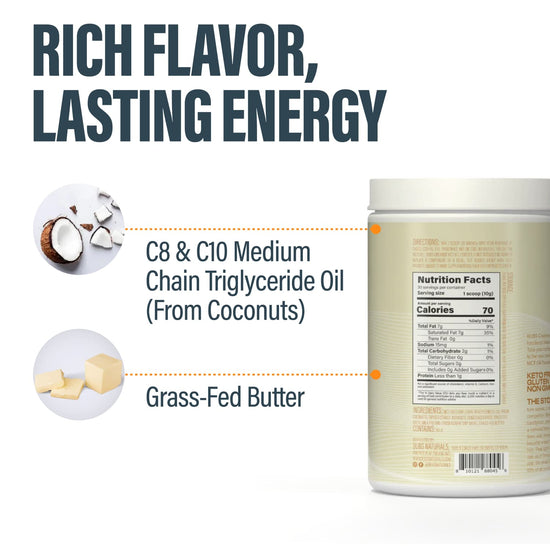Table of Contents
- Introduction
- Understanding Non-Dairy Creamers
- The Science of Frothing
- Frothing Techniques and Tools
- Tips for Perfect Froth
- The Benefits of Frothing Non-Dairy Creamers
- Conclusion
- FAQ
Introduction
Have you ever found yourself yearning for a frothy coffee from your favorite café, only to be disappointed by the limitations of non-dairy creamers? You're not alone. Many coffee enthusiasts who opt for non-dairy alternatives face challenges when it comes to achieving that perfect frothy texture. The good news is that with the right techniques and knowledge, you can indeed froth non-dairy creamers effectively.
As we delve into this topic, we'll explore the various types of non-dairy creamers available, the science behind frothing, and practical tips to help you achieve that café-style froth at home. We'll also touch on how BUBS Naturals' commitment to clean, functional ingredients can enhance your coffee experience. By the end of this blog post, you’ll be equipped with everything you need to know about frothing non-dairy creamers, turning your kitchen into a barista-style coffee haven.
In this post, we will cover:
- The types of non-dairy creamers that froth well
- The frothing process and tools you can use
- Tips for the best frothing results
- The benefits of using quality ingredients, such as those found in BUBS Naturals products
- Answers to frequently asked questions about frothing non-dairy creamers
So, can you froth non-dairy creamer? Let’s dive in and find out how to elevate your coffee routine!
Understanding Non-Dairy Creamers
Non-dairy creamers are popular for those looking to avoid dairy for dietary, ethical, or health reasons. With a wide array of options available on the market, it’s essential to understand their composition to determine which ones froth best.
Types of Non-Dairy Creamers
-
Almond Milk: Almond milk is a popular choice for many coffee drinkers. While it has a light flavor, its frothing capabilities can vary by brand. Look for barista blends designed for frothing, as they often contain added stabilizers for a better froth.
-
Oat Milk: Oat milk has become a favorite in the coffee community due to its creamy texture and ability to froth well. Brands like Califia Farms and Oatly's Barista Edition are well-received for their frothing capabilities.
-
Coconut Milk: Coconut milk can add a unique flavor to coffee, but its frothing ability depends on the fat content. Creamier versions, such as those found in canned coconut milk, froth better than lighter varieties.
-
Soy Milk: Soy milk is another versatile option that can froth effectively. Look for unsweetened varieties to avoid excess sugars that can affect frothing.
-
Cashew Milk: Cashew milk is creamy and can froth nicely. While it may not have the same stability as some other options, it can still work well for lattes and cappuccinos.
-
Rice Milk: Rice milk is the least creamy of the options and is often less successful at frothing. It can be used in combination with other creamers for better results.
The Importance of Ingredients
At BUBS Naturals, we believe in the power of clean, high-quality ingredients. Our mission is to provide products that support active lifestyles and promote wellness. By choosing non-dairy creamers with fewer additives and sugars, you're not just improving your coffee experience; you're also nourishing your body.
The Science of Frothing
Frothing is all about incorporating air into the liquid, which creates a light and airy texture. The ability of a creamer to froth well depends on its fat content, protein levels, and the presence of stabilizers. Here's how these factors play a role:
-
Fat Content: Higher fat content generally leads to better frothing. Creamy non-dairy options, like oat and soy milk, tend to froth better than lighter alternatives.
-
Protein: Proteins stabilize the bubbles formed during frothing. This is why barista blends often contain added proteins or emulsifiers, which help achieve a stable froth.
-
Temperature: Heating the non-dairy creamer before frothing can enhance the process. Warm liquids froth better, as the heat helps to break down fats and proteins, allowing for better air incorporation.
Frothing Techniques and Tools
Now that we understand the basics, let’s explore some practical methods and tools for frothing non-dairy creamers.
Frothing with a Milk Frother
An electric milk frother is one of the easiest ways to achieve a perfect froth. Simply pour your non-dairy creamer into the frother, turn it on, and let it do its magic. This method is quick and requires minimal effort.
Using a French Press
A French press can also be an effective tool for frothing. Here’s how:
- Heat your non-dairy creamer to a warm temperature.
- Pour it into the French press, filling it about halfway.
- Place the lid on and pump the plunger up and down vigorously for about 30 seconds.
- Watch as the froth develops!
The Mason Jar Method
If you don’t have any fancy equipment, you can use a mason jar. Here's how:
- Fill the mason jar halfway with warm non-dairy creamer.
- Secure the lid tightly and shake vigorously for about 30-45 seconds until frothy.
- Remove the lid and microwave the jar for about 30 seconds to stabilize the froth.
Steam Wand
If you have an espresso machine, using a steam wand is one of the best methods for frothing. Here's how to do it:
- Fill a metal pitcher with your non-dairy creamer.
- Insert the steam wand and turn it on, positioning it just below the surface of the creamer.
- As the froth begins to form, lower the wand deeper into the pitcher to heat the cream.
Tips for Perfect Froth
Achieving the perfect froth involves a few key considerations:
- Choose Quality Creamers: Opt for non-dairy creamers that are specifically designed for frothing, such as BUBS Naturals’ MCT Oil Powder, which can be a great addition to your coffee.
- Experiment with Brands: Not all non-dairy creamers are created equal. You may need to try a few different brands to find the one that froths best for your taste.
- Temperature Matters: Warm your non-dairy creamer slightly before frothing. Aim for a temperature between 140-160°F for optimal frothing results.
- Add Stabilizers if Needed: If you're making homemade non-dairy milk, consider adding a small amount of sunflower lecithin or other emulsifiers to improve frothing capability.
The Benefits of Frothing Non-Dairy Creamers
Frothing non-dairy creamers not only elevates your coffee experience but also offers a range of benefits:
- Customizable Flavor: You can experiment with different non-dairy creamers to find the perfect flavor profile for your coffee.
- Healthier Options: Many non-dairy creamers are lower in calories and sugars compared to traditional creamers, making them a healthier choice for coffee lovers.
- Dairy-Free Enjoyment: For those with lactose intolerance or dairy allergies, frothing non-dairy creamers allows you to enjoy the creamy texture of coffee without discomfort.
Conclusion
In conclusion, the answer to the question, “Can you froth non-dairy creamer?” is a resounding yes. With the right techniques and ingredients, you can achieve a frothy, café-style coffee experience right in your home. By experimenting with various non-dairy creamers and utilizing the frothing methods we've discussed, you can enjoy delicious, frothy beverages that cater to your dietary preferences.
At BUBS Naturals, we’re dedicated to providing clean and functional ingredients that support wellness and adventure. Explore our range of products, including our premium MCT Oil Powder, to enhance your coffee experience even further. Together, let’s elevate your coffee routine!
FAQ
1. What non-dairy creamers froth best? Barista blends of oat milk and soy milk are known to froth well due to their fat and protein content. Almond milk can also work, but results may vary by brand.
2. Can I froth store-bought non-dairy creamers? Yes, many store-bought non-dairy creamers can be frothed, but look for those labeled as "barista" or "for coffee" to ensure better results.
3. How can I froth non-dairy creamer without a frother? You can froth non-dairy creamer using a French press or a mason jar. Just warm the creamer and shake or pump it to incorporate air.
4. Why does my froth not hold up? The stability of froth can be affected by the type of non-dairy creamer used. Lower fat content and lack of stabilizers can cause the froth to collapse.
5. Can I froth homemade non-dairy milk? Yes, you can froth homemade non-dairy milk, but consider adding sunflower lecithin or other emulsifiers to help stabilize the froth.
With these insights and techniques, you're now ready to enjoy delicious, frothy non-dairy coffee creations. Happy frothing!
Written by:

Butter MCT Oil Creamer
BUBS Butter MCT Oil Creamer (formerly Halo Creamer): Scientifically-Backed Brain and Body Fuel
BUBS Butter MCT Oil Creamer is your go-to for clean, fast-acting energy and focus, no crash included. It blends creamy grass-fed butter with fast-acting MCT oil powder (C8 and C10) to kickstart your day and keep you sharp. The MCTs go straight to work, giving your brain a quick boost while the grass-fed butter supports digestion and gut health.
Together, they help curb cravings, keep you feeling full longer, and support steady energy throughout the day—perfect for fueling your mornings or powering through the afternoon slump.
Starts at $37.00
Shop

